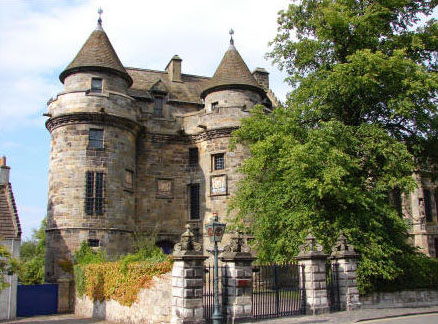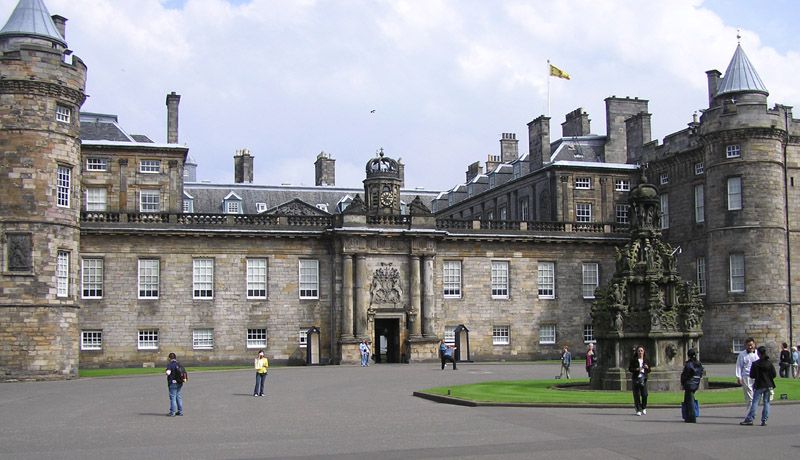Falkland Palace in Falkland, Fife, Scotland, is a royal palace of the Scottish Kings. Today it is under the stewardship of the Marquis of Bute, who delegates most of his duties to the National Trust for Scotland.
Before Falkland Palace was built a hunting lodge existed on the site in the 12th century. This lodge was expanded in the 13th century and became a castle which was owned by the Earls of Fife - the famous Clan MacDuff. The castle was built here because the area could be easily defended as it was on a slight hill. The surrounding land eventually became the Palace gardens.
There was a great wood of oaks to the north between the royal stable and the River Eden, with many groves merging into the surrounding parkland. Timber was occasionally cut in the forest for royal ships of war. The castle would also have been surrounded by meadows, fields, orchards, glades and Falkland Park which was a managed forest surrounded by a Pale, which is a ditch with a fence on top of it. This pale would have been used to keep game inside the park for the royal family and courtiers to hunt. The land near the palace which is currently the orchard would have originally been meadows. The castle and the palace would have had their own orchard somewhere close by. In 1371 Falkland Castle was destroyed in by an invading English army.
In 1402 Robert, Duke of Albany imprisoned his nephew and rival David, Duke of Rothesay, the eldest son of King Robert, in the Well Tower at Falkland. The incarcerated Duke eventually died there from neglect and starvation.
Albany was exonerated from blame by Parliament, but suspicions of foul play persisted, suspicions which never left Rothesay's younger brother the future King James, and which would eventually lead to the downfall of the Albany Stewarts. John Debrett, writing in 1805, was in no doubt of Duke Robert's motives and guilt:
This Robert, Duke of Albany, having obtained the entire government from his brother, King Robert, he caused the Duke of Rothesay to be murdered, thinking to bring the Crown into his own family; but to avoid the like fate, King Robert resolved to send his younger son James, to France, then about nine years old, who being sea-sick, and forced to land on the English coast ... was detained a captive in England eighteen years. At these misfortunes King Robert died of grief in 1406.
Between 1501 and 1541 Kings James IV and James V transformed the old castle into a beautiful royal palace: with Stirling Castle it was one of two Renaissance palaces in Scotland. To address the poor state of the garden and park, James V appointed a new Captain and Keeper, William Barclay, Master of Rhynd, in March 1527.Ten years later, James V extended his father's buildings in French renaissance style. He built a Royal Tennis Court in the grounds of the Palace which was completed in 1541. The court still survives to this day and is the oldest in Britain. James died at Falkland Palace in December 1542, from an illness induced by the shock and grief of his army's defeat at Solway Moss and of his wife's failure to give him a male heir, instead giving birth to the future Mary, Queen of Scots.His body lay in the Chapel Royal for almost a month and the Chapel was draped in black. On 4 January 1543 messengers ordered the gentlemen of Fife to convey the king's body to North Queensferry on its way to Holyrood Abbey.
Falkland became a popular retreat with all the Stewart monarchs. They practised falconry there and used the vast surrounding forests for hawking and for hunting deer. Wild boar, imported from France, were kept in the Park, within a fence made by the Laird of Fernie. They also loved using the Royal Tennis Court; Queen Mary became especially fond of the game, and it is recorded that she scandalised the people of Scotland by wearing men's breeches to play.
Nearby Myres Castle is the hereditary home of the Royal Macers and Sergeants at Arms who served Falkland Castle since at least the 16th century. John Scrimgeour of Myres supervised building at the Palace from 1532 to 1563.
After the Union of the Crowns (1606), Kings James VI, Charles I, and Charles II all visited Falkland. A fire partially destroyed the palace during its occupation by Cromwell's troops, and it quickly fell into ruin.
In 1887 John, 3rd Marquis of Bute purchased the estates of Falkland and started a 20-year restoration of the palace using his two right-hand architects: John Kinross and Robert Weir Schultz. At the time the Palace was a ruin with no windows or doors. Thanks to his sympathetic restoration work and considerable budget the Palace is still standing to this day. Many features in and around the Palace show evidence of his work, such as the "B" on the guttering and portraits of his children carved into a cupboard door in the Keeper's Dressing Room.
During the time of Marquis John, the ornamental kitchen garden was enhanced by a pergola and decorative vases. The north part of the "upper garden" was redesigned to express the foundations of Falkland Castle and Palace North Range which were uncovered during the Marquis's archaeological excavations. Walls were built on top of the foundations for the Well Tower and the Great Hall to emphasise the structures.
The Orchard and Palace gardens were linked to the House of Falkland by the private walk and new bridges. Houses were built near to the palace and connected into the ornamental kitchen garden and orchard by a system of new public and private paths. The ground around the curling pond (to the North East of the orchard) was planted with trees and shrubs and laid out in flower plots.
The enclosing yew hedge around the pond garden is a typical feature of period. The lime tree avenue which is north of the palace gatehouse was built sometime between 1894 and 1912-13 according to the Ordinance Surveys of those periods. The Victorian glass house was built in 1890 by Mckenzie and Moncur from Edinburgh for Lord Bute and was used mainly to grow flowers and exotic plants. Plant hunting was popular at this time and people of wealth would travel the world to find specimens and bring them home to plant in their gardens and show them off to their friends. There is also evidence that there was a second glass house in the garden near the existing one.











